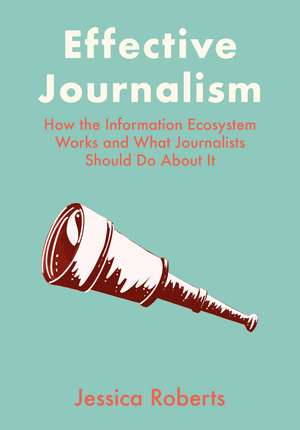Effective Journalism: How the Information Ecosystem Works and What Journalists Should Do About It
Autor Jessica Robertsen Limba Engleză Hardback – 17 apr 2024
The central argument of this book is that journalists and audiences can no longer afford to pretend that all information is competing on an even playing field and that it is enough for journalists to simply publish “the facts.” Effective Journalism attempts to explain the reality, rather than the ideal, of how people seek and process information, and what journalists and their audiences can do to try to create an informed public in the face of that reality.
Preț: 599.18 lei
Preț vechi: 778.17 lei
-23% Nou
Puncte Express: 899
Preț estimativ în valută:
114.65€ • 120.03$ • 94.87£
114.65€ • 120.03$ • 94.87£
Carte disponibilă
Livrare economică 15-29 martie
Livrare express 01-07 martie pentru 31.53 lei
Preluare comenzi: 021 569.72.76
Specificații
ISBN-13: 9781789389036
ISBN-10: 1789389038
Pagini: 202
Dimensiuni: 170 x 244 x 18 mm
Greutate: 0.52 kg
Editura: Intellect Ltd
Colecția Intellect Ltd
ISBN-10: 1789389038
Pagini: 202
Dimensiuni: 170 x 244 x 18 mm
Greutate: 0.52 kg
Editura: Intellect Ltd
Colecția Intellect Ltd
Notă biografică
Jessica Roberts is professor of journalism and social media at the Universidade Católica Portuguesa.
Cuprins
Acknowledgements
Introduction
PART I: STRUCTURAL CHALLENGES IN OUR INFORMATION ECOSYSTEM
1. Information Proliferation
2. The Attention Economy
3. Customization and Filters and Bots
4. The Competitive Advantage of Junk News
PART II: COGNITIVE AND AFFECTIVE BARRIERS TO PROCESSING INFORMATION
5. The Dual-Process Model
6. Motivated Reasoning and Bias
7. Emotion and Information
PART III: THE SOLUTIONS
8. New Movements in Journalism
9. Strategies to Effectively Debunk False Information
10. Empathy Cultivation and Building Community
11. Effective Journalism Practices
12. Solutions for Tech Companies, Government, and the Public
Conclusion
Index
Introduction
PART I: STRUCTURAL CHALLENGES IN OUR INFORMATION ECOSYSTEM
1. Information Proliferation
2. The Attention Economy
3. Customization and Filters and Bots
4. The Competitive Advantage of Junk News
PART II: COGNITIVE AND AFFECTIVE BARRIERS TO PROCESSING INFORMATION
5. The Dual-Process Model
6. Motivated Reasoning and Bias
7. Emotion and Information
PART III: THE SOLUTIONS
8. New Movements in Journalism
9. Strategies to Effectively Debunk False Information
10. Empathy Cultivation and Building Community
11. Effective Journalism Practices
12. Solutions for Tech Companies, Government, and the Public
Conclusion
Index
